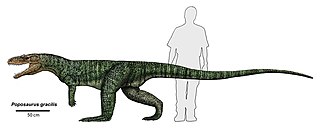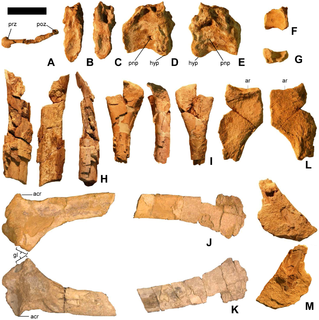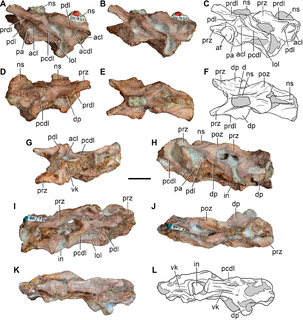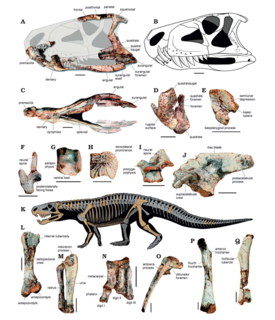
Gojirasaurus is a dubious genus of coelophysoid theropod dinosaur named after the giant monster movie character Gojira.

Nanshiungosaurus is a genus of therizinosaurid that lived in what is now Asia during the Late Cretaceous of South China. The type species, Nanshiungosaurus brevispinus, was first discovered in 1974 and described in 1979 by Dong Zhiming. It is represented by a single specimen preserving most of the cervical and dorsal vertebrae with the pelvis. A supposed and unlikely second species, "Nanshiungosaurus" bohlini, was found in 1992 and described in 1997. It is also represented by vertebrae but this species however, differs in geological age and lacks authentic characteristics compared to the type, making its affinity to the genus unsupported.
Calyptosuchus is an extinct genus of aetosaur from the Late Triassic of North America. Like other aetosaurs, it was heavily armored and had a pig-like snout used to uproot plants.
Lophostropheus is an extinct genus of coelophysoid theropod dinosaur that lived approximately 205.6 to 196.5 million years ago during the boundary between the Late Triassic Period and the Early Jurassic Period, in what is now Normandy, France. Lophostropheus is one of the few dinosaurs that may have survived the Triassic–Jurassic extinction event.

Poposauroidea is a clade of advanced pseudosuchians. It includes poposaurids, shuvosaurids, ctenosauriscids, and other unusual pseudosuchians such as Qianosuchus and Lotosaurus. However, it excludes most large predatory quadrupedal "rauisuchians" such as rauisuchids and "prestosuchids". Those reptiles are now allied with crocodylomorphs in a clade known as Loricata, which is the sister taxon to the poposauroids in the clade Paracrocodylomorpha. Although it was first formally defined in 2007, the name "Poposauroidea" has been used for many years. The group has been referred to as Poposauridae by some authors, although this name is often used more narrowly to refer to the family that includes Poposaurus and its close relatives.

The vertebral column, also known as the backbone or spine, is part of the axial skeleton. The vertebral column is the defining characteristic of a vertebrate in which the notochord found in all chordates has been replaced by a segmented series of bone: vertebrae separated by intervertebral discs. The vertebral column houses the spinal canal, a cavity that encloses and protects the spinal cord.

Martharaptor is a genus of therizinosauroid theropod dinosaurs from the Early Cretaceous of the Cedar Mountain Formation in Utah. They can be distinguished from other therizinosauroids by means of several features of the skeleton which were intermediate between early therizinosaurs such as Falcarius and Beipiaosaurus, and more "advanced" members of the group like therizinosaurids. The deep and homogeneous hand claws clearly differ from the case in early therizinosauroids, but the foot has not yet acquired the robust morphology of therizinosaurids.

Dahalokely is an extinct genus of carnivorous abelisauroid theropod dinosaur from the Late Cretaceous (Turonian) of Madagascar.

Eorasaurus is an extinct genus of archosauromorph reptile known from the middle Late Permian of Tatarstan, European Russia. It contains a single species, Eorasaurus olsoni. When originally described by Sennikov (1997), Eorasaurus was identified as an early archosauromorph and assigned to the family Protorosauridae, Ezcurra et al. (2014) and Ezcurra (2016) later reclassified Eorasaurus and placed it within the group Archosauriformes. Eorasaurus is based solely on scant fossil material from the neck region, and is thus considered an unstable taxon in phylogenetic analyses. If Eorasaurus is an archosauriform, it would be the oldest known member of the group and would pre-date the previous record holder.

Katepensaurus is an extinct genus of rebbachisaurid sauropod dinosaur known from the Late Cretaceous of south-central Chubut Province of central Patagonia, Argentina. It contains a single species, Katepensaurus goicoecheai.
This glossary explains technical terms commonly employed in the description of dinosaur body fossils. Besides dinosaur-specific terms, it covers terms with wider usage, when these are of central importance in the study of dinosaurs or when their discussion in the context of dinosaurs is beneficial. The glossary does not cover ichnological and bone histological terms, nor does it cover measurements.
Panguraptor is a genus of coelophysid theropod dinosaur known from fossils discovered in Lower Jurassic rocks of southern China. The type and only known species is Panguraptor lufengensis. The generic name refers to the deity Pangu but also to the supercontinent Pangaea for which in a geological context the same characters are used: 盘古. Raptor means "seizer", "robber" in Latin. The specific name is a reference to the Lufeng Formation. The holotype specimen was recovered on 12 October 2007 from the Lufeng Formation of Yunnan, which is noted for sauropodomorph fossils. It was described in 2014 by You Hai-Lu and colleagues.

In the vertebrate spinal column, each vertebra is an irregular bone with a complex structure composed of bone and some hyaline cartilage, the proportions of which vary according to the segment of the backbone and the species of vertebrate.

Austroposeidon is an extinct genus of titanosaurian sauropod dinosaur from the Late Cretaceous Presidente Prudente Formation of Brazil. It contains one species, Austroposeidon magnificus.
Tratayenia is an extinct genus of megaraptoran theropod dinosaurs known from remains found in the Santonian-age Bajo de la Carpa Formation of Argentina. The type and only species, Tratayenia rosalesi, was described in March 2018.
Ingentia is a genus of early sauropod dinosaur from the Late Triassic of Argentina. The type specimen of Ingentia, PVSJ 1086, was discovered in the Quebrada del Barro Formation of northwestern Argentina. It was described in 2018 by Cecilia Apaldetti, Ricardo Nestor Martínez, Ignacio Alejandro Cerda, Diego Pol and Oscar Alcober who named the type and only species Ingentia prima, meaning "first huge one", as the taxon was one of the first very large sauropodomorphs to evolve, along with its close relative Lessemsaurus. A second specimen, PVSJ 1087, was referred, containing five tail vertebrae, both ulnae and radii, a left calfbone and a right foot.

Nhandumirim is a genus of basal sauropodomorph dinosaur from the Carnian age of Late Triassic Brazil. It is a saturnaliine sauropodomorph. The type and only species, Nhandumirim waldsangae, is known from a single immature specimen including vertebrae, a chevron, pelvic material, and a hindlimb found in the Santa Maria Formation in Rio Grande do Sul. Nhandumirim is differentiated from other Santa Maria dinosaurs such as Staurikosaurus and Saturnalia on the basis of its more gracile, long-legged proportions and several more specific skeletal features. It also possessed several unique features compared to other early dinosaurs, such as long keels on vertebrae at the base of the tail, a straight metatarsal IV, and a short brevis fossa of the ilium and dorsolateral trochanter of the femur. Several features of the tibia led the describers of the genus and species to consider Nhandumirimwaldsangae the earliest theropod, but some analyses in their study offer alternative positions within Saurischia. All subsequent studies considered Nhandumirim an early sauropodomorph, closely-associated with Saturnalia and Chromogisaurus.
Exapophyses are bony joints present in the cervicals of some pterosaurs. Exapophyses lie on the centrum, the spool-shaped main body of each vertebra, where they are positioned adjacent to the main articulating surfaces between centra. Exapophyses which are next to the cotyle are known as preexapophyses while those at the condyle are called postexapophyses. Exapophyses act as accessory articulations, meaning that they complement the cotyle and condyle, as well as the zygapophyses. The term was coined by Samuel Wendell Williston in 1897 during a description of Pteranodon. Exapophyses are a defining trait of the pterosaur subgroup Eupterodactyloidea, although they are also known to occur in some ctenochasmatids. Rhamphorhynchids have paired, knob-like extensions on the condyle which are occasionally also termed exapophyses, but these extensions are not distinctly offset and are not considered homologous to the exapophyses of eupterodactyloids and ctenochasmatids.

Dynamosuchus is an extinct genus of pseudosuchian archosaurs from the family Ornithosuchidae. It is known from a single species, Dynamosuchus collisensis, which is based on a partial skeleton from the Santa Maria Formation of Brazil. Dynamosuchus is considered a close relative of Venaticosuchus, which is known from the Ischigualasto Formation of Argentina. Ornithosuchids are one of many groups which lived in the Santa Maria and Ischigualasto Formations, which formed at approximately the same time and were ecologically similar. As a large scavenging reptile, Dynamosuchus helps to illuminate the trophic structure of the Santa Maria Formation. It also supports the hypothesis that ornithosuchids had diversified throughout South America by the start of the Carnian, and were not originally endemic to the Ischigualasto-Villa Unión Basin.

Incertovenator is an extinct genus of archosauriform reptile, likely an archosaur, of uncertain affinities. Its unstable position is a result of possessing a number features found in both the bird-line avemetatarsalian archosaurs and the crocodylian-line pseudosuchians. The type and only known species is I. longicollum, which is known from single specimen discovered in the Late Triassic Ischigualasto Formation of Argentina. Incertovenator is known almost entirely by its vertebral column. This indicates that it had a relatively long neck, leading to its uncertain classification due to the convergent evolution of elongated neck vertebrae in both avemetatarsalian and pseudosuchian archosaurs.



























